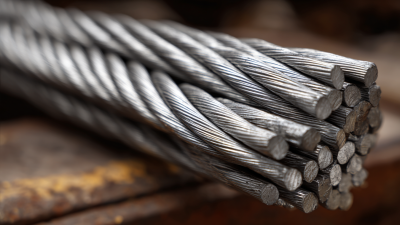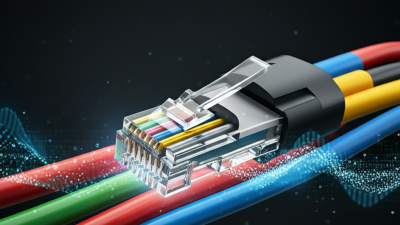
-
Home
-
Products
-
PVC Cable Material
-
Low Smoke Zero Halogen Cable Material
-
Cable material
-
Optical fiber cable
-
-
About Us
-
VR
-
News
-
Blog
-
Contact Us
Leave Your Message

In the ever-evolving landscape of electrical and telecommunications infrastructure, understanding the nuances of Pe Cable Material has become paramount for procurement professionals seeking optimal strategies. According to a recent industry report by MarketsandMarkets, the global market for cable materials is projected to reach $20 billion by 2025, reflecting a compound annual growth rate (CAGR) of 4.5%. As the demand for high-performance and durable cable solutions increases, variations in Pe Cable Material, such as density, thermal conductivity, and environmental resistance, significantly influence procurement decisions. Exploring these variations ensures that businesses not only source materials that meet technical specifications but also offer cost efficiency and sustainability—crucial factors in today’s competitive markets. This blog aims to provide in-depth insights and practical solutions for navigating the complexities of Pe Cable Material, ultimately enhancing procurement strategies across various sectors.

When it comes to procuring PE cable materials, understanding their key characteristics is essential for making informed decisions. One of the primary traits to consider is the density of the polyethylene used in the cables. High-density polyethylene (HDPE) offers superior durability and resistance to environmental stressors, making it ideal for applications in harsh conditions. Conversely, low-density polyethylene (LDPE) may provide better flexibility, which can be advantageous in installations that require maneuverability and ease of handling.
Another critical factor is the thermal and electrical insulation properties of PE cables. The ability of insulation to withstand high temperatures without degrading is vital in preventing electrical failures and enhancing safety. Additionally, consider the dielectric strength of the material, as this will influence the cable’s performance in electrical applications. Understanding these characteristics not only facilitates effective procurement strategies but also helps in selecting the right type of PE cable material that matches the specific requirements of each project. Balancing flexibility with durability and insulation properties will lead to greater efficiency and longevity in cable performance.
Understanding the cost-effectiveness of different PE cable types is crucial for optimizing procurement strategies. The global thermoplastic pipe market is expected to see significant growth, rising from $4.05 billion in 2024 to an estimated $4.31 billion in 2025. This upward trend indicates a rising demand for high-performance materials, including various types of PE cables that cater to diverse industry needs.
When analyzing the cost-effectiveness of different PE cable types, it is essential to consider factors such as material quality, durability, and application suitability. For instance, HDPE (High-Density Polyethylene) cables are often favored for their robustness in harsh conditions, which may lead to lower maintenance costs over their lifespan. In contrast, lower-cost variants might present significant long-term expenses due to frequent replacements or repairs, highlighting the importance of an upfront investment assessment. As the industry evolves, procurement strategies must adapt to prioritize not only initial costs but also total lifecycle costs to ensure optimal returns and sustainability in operations.

When sourcing high-quality polyethylene (PE) cables in today’s competitive market, it's essential to understand the variations in material quality that can significantly impact performance. Start by identifying suppliers who specialize in PE cables and have a proven track record in the industry. Look for certifications and testing standards that ensure the cables are durable and can withstand environmental challenges. Engaging with suppliers that prioritize quality control can help mitigate risks associated with material failure and ensure long-term reliability in your projects.
Another key strategy is to conduct thorough market research to compare the specifications and prices of different PE cable options. Analyzing the properties of cables, such as their UV resistance, temperature tolerance, and flexibility, can help you make informed decisions that align with your specific application needs. Additionally, building relationships with manufacturers can provide valuable insights and potentially better pricing or exclusive offerings. By focusing on both the quality and source of your PE cables, you can develop an optimal procurement strategy that not only meets your project requirements but also positions your business competitively in the marketplace.
| Material Type | Temperature Range (°C) | Typical Applications | Weight per Meter (kg) | Cost per Meter (USD) | Durability Rating (Years) |
|---|---|---|---|---|---|
| LDPE | -40 to 80 | Low voltage applications, outdoor wiring | 0.5 | 0.20 | 10 |
| HDPE | -50 to 65 | Telecommunications, water pipes | 0.8 | 0.30 | 15 |
| MDPE | -30 to 80 | Gas distribution, medium pressure systems | 0.7 | 0.25 | 12 |
| XLPE | -40 to 90 | High voltage cables, renewable energy | 1.0 | 1.00 | 20 |
When procuring PE (polyethylene) cables, identifying supplier reliability is paramount to ensuring that the quality and performance match your project's requirements. A recent industry report by Research and Markets highlights that the global PE cable market was valued at approximately $12 billion in 2022, with a projected growth rate of 5.3% from 2023 to 2030. This growth underlines the importance of partnering with suppliers who not only provide quality materials but also demonstrate a consistent ability to meet demand.
Factors to evaluate when considering supplier reliability include production capacity, quality assurance processes, and historical performance metrics. The International Organization for Standardization (ISO) standards, particularly ISO 9001, provide a framework to assess a supplier's quality management system. Moreover, a comprehensive review of customer feedback and supplier ratings can offer insights into their responsiveness and problem-solving capabilities. According to a study by Mordor Intelligence, 78% of procurement professionals prioritize supplier performance history as a key factor in their selection process. By focusing on these evaluation criteria, businesses can secure reliable suppliers that enhance their procurement strategies and ultimately contribute to project success.

As the demand for high-performance polyethylene (PE) cables continues to grow, understanding the future trends in PE cable materials is crucial for buyers looking to optimize their procurement strategies. The evolving landscape of cable materials will not only affect product performance but also the overall cost structure. With anticipated changes in regulations, such as the upcoming GST adjustments on construction materials in 2025, buyers need to stay informed about how these shifts could impact pricing for PE cables and related components.
Recent reports indicate a notable trend towards eco-friendly and sustainable materials in the manufacturing of PE cables. This move aligns with the increasing awareness of environmental responsibilities among consumers and industries alike. Buyers should be aware that sourcing PE cables produced with sustainable materials might not only comply with future regulations but also appeal to a growing market segment that prioritizes eco-conscious solutions. Staying ahead of these trends will allow procurement professionals to make informed decisions that enhance their product offerings and ensure competitive advantages in the market.





